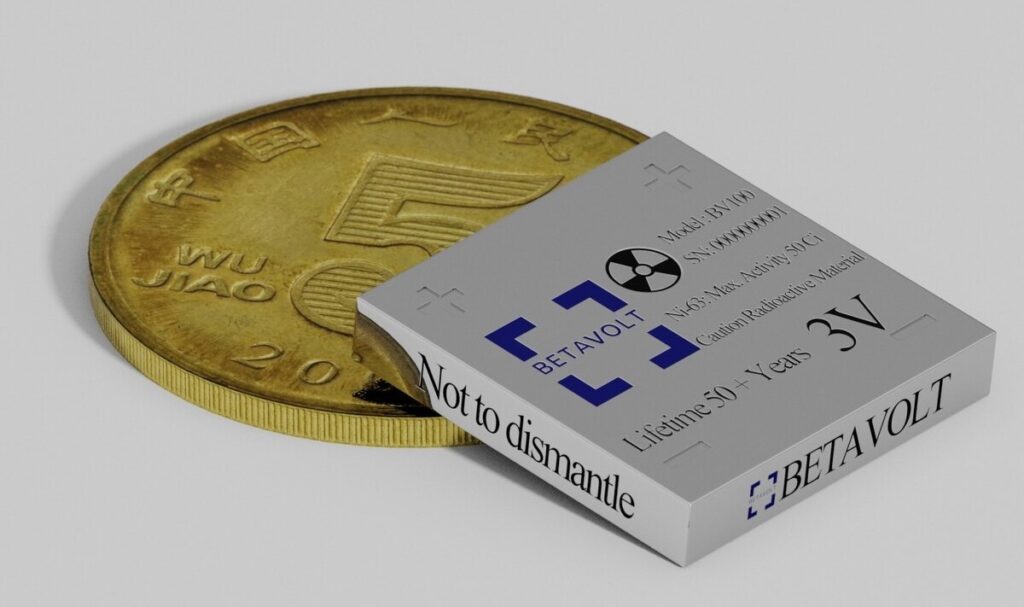
Chinese startup Betavolt has announced a nuclear battery that boasts a staggering operational life of 50 years without the need for charging or maintenance. It marks a significant milestone in the miniaturization of atomic energy, encapsulating 63 nuclear isotopes into a module smaller than a coin.
The possibilities here are truly stunning. Imagine phones and other mobile devices that keep on running without having to charge. Or think about drones that can fly almost indefinitely, compared to today’s energy-devouring quadcopters that can barely stay up for half an hour.
Okay, now calm down for a second because we’re not exactly there yet. But that’s the direction things seem to be heading in. Oh, and I can already sense your objection concerning this rather trivial thing about walking around with some glowing, radioactive device in your back pocket. More on that in a minute.
First, let’s talk technology.
Batteries that last for 50 years? Not as crazy as it sounds
The principle behind this nuclear battery is not new. Originating from the 20th century, the concept involves converting energy released by decaying isotopes into electricity. This technology has previously been utilized in spacecraft, underwater systems, and remote scientific stations by the Soviet Union and the United States. However, the challenge has always been the size and cost. And maybe safety too.
Betavolt’s design harnesses radiation emitted by nickel isotopes, which is converted into electricity. What the Beijing-based Betavolt managed to achieve so far is a prototype nuclear battery that delivers 100 microwatts of power, all crammed into a volume of just 15x15x5 cubic millimeters. That’s only enough to maybe power Radio-frequency identification (RFID) tags or some very low-power sensors.
The plan is to scale the design up to 1 watt by 2025, which could power some microcontrollers and some of the more efficient LED lights. That’s still not enough to power a phone by itself, but by linking many of these tiny batteries or modules in series, it’s possible. Betavolt says that the energy density is 10 times that of similar-sized lithium batteries.
“If policies permit, atomic energy batteries can allow a mobile phone to never be charged, and drones that can only fly for 15 minutes can fly continuously,” Betavolt says in a statement.
Betavolts claims — and we’ll have to take their word for it, for now — that these batteries cannot catch fire or explode, unlike lithium-ion batteries powering current smartphones and electric vehicles. The nuclear batteries can also run in temperatures ranging from -60 degrees Celsius to 120 degrees Celsius.
Nickel isotopes release beta particles — high energy, high-speed electrons with low mass. In general, beta particles have a greater ability to penetrate other materials than the much larger alpha particles. As a result, these particles can travel a few feet in the air from their source and can penetrate the skin, potentially causing burns and even damaging DNA. Nonetheless, a thin sheet of metal or plastic or just a block of wood can stop beta particles. With proper casing to shield users from radiation, the battery should be safe.
Like with lithium-ion batteries, the real danger of beta particle radiation sources is when they’re inhaled or ingested. Betavolt assures us that its atomic energy battery is completely safe with no external radiation, making it suitable even for sensitive medical devices such as pacemakers and cochlear implants. Furthermore, the company highlights the environmental friendliness of its product. After the decay period lasting decades, the isotopes transform into a stable, non-radioactive isotope of copper, posing no environmental threat or pollution.
It sounds almost too good to be true, which is always a good time to be skeptical. We’re only relying on corporate PR at this point, so I wouldn’t get too excited until we have independent researchers reviewing this kind of tech.
Betavolt has big plans. It wants to enter commercial mass production in 2025. However, are consumers ready to walk about their daily lives with a radioactive device in their pockets or palms? I bet that most people would be strongly against it, safety guarantees notwithstanding. Prove me wrong.
Betavolt isn’t alone though. In Australia, PhosEnergy is working with the University of Adelaide on their own version of a beta decay battery pack. However, they’re not aiming for the commercial market, as their power pack is meant for space-based satellites and rovers, which are as far removed from humans as they come.
Was this helpful?



